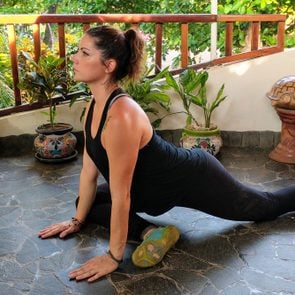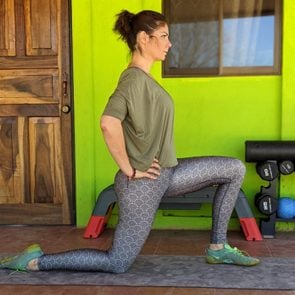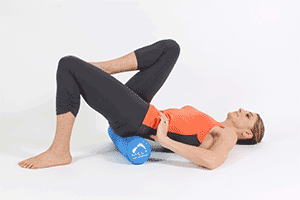4 Glute Stretches That Help Ease Tightness and Prevent Pain
Updated: Jun. 10, 2021
If you're experiencing pain in your lower body, you may need to spend more time doing glute stretches. Experts love these four stretches to alleviate tightness and tension.
How to stretch your glutes
You may spend a lot of time in the gym (or at home) working on your glutes.
These large muscles, which make up your butt, are the powerhouse of your lower body, helping you perform practically every major movement you can think of.
Without your glutes, you’d be hard-pressed to walk, squat, dance, do a dead lift or side-slide, or pivot.
But while you may spend a lot of time strengthening your glutes, you may not spend as much time stretching them out.
Unfortunately, failure to keep these muscles supple and limber can also lead to pain and injuries.
Why glute flexibility is important
The glutes make you move. And movement—adequate mobility—requires strength and flexibility. Without a good range of motion through your joints, you’re not going to be able to move like you’d like to.
The muscles that make up the glutes include the gluteus maximus, which helps you extend your thigh and rotate your hip externally, and the gluteus medius and minimus, which help rotate the hips internally.
“Tight glutes that aren’t able to relax will restrict hip movement and force extension to come from the lower back, instead,” says Jake Harcoff, head coach and owner of AIM Athletic in Langley, British Columbia, Canada.
And any time you’re using one muscle group to perform the actions that are intended to be performed by a different muscle group, you’re setting yourself up for problems.
As Harcoff explains, when the low back takes over, you may end up experiencing poor posture, low back pain, and hip pain, such as impingements (when the ball and socket of the hip joint rub together) and bursitis (inflammation of a small, fluid-filled sac that cushions the bone).
Going beyond the glutes
The problems with tight glutes become compounded when you consider the role and action of the tensor fascia latae (TFL) muscle in the thigh.
The glutes are charged with internal and external hip rotation, and the TFL contributes to internal hip rotation.
“When the glutes become too tight and inactive, the TFL begins to carry the internal rotation and becomes overworked,” Harcoff says. “When the TFL becomes tight, it begins to pull on and tighten the IT band. Over time, this can lead to lateralized knee pain and back pain.”
Just as the TFL can compensate for internal hip rotation, the piriformis muscle can compensate for external hip rotation.
The piriformis is a deep, hip-stabilizing muscle located under the gluteus maximus. It attaches from the sacrum (a bony structure at the base of the spine that’s attached to the pelvis) to the top of the thighbone, extending across the sciatic nerve.
“Tightness in the piriformis can put pressure on the sciatic nerve, causing symptoms of sciatica,” says Alissa Tucker, a master trainer with AKT, a dance-based workout studio.
In other words, when the glutes are tight and their range of motion is limited, other, smaller muscles start taking on their job. And this can have a domino effect: if these muscles become tight and overworked, more pain, injuries, and problems with mobility can arise.
That’s why it’s important to not only stretch and strengthen the glutes but also make sure you’re performing stretches and activities that help to loosen up the piriformis and TFL as well.
Glute stretches to ease tightness
It’s important to realize that while you may think of your glutes as being located primarily behind your pelvis, on the backside of your body, your glutes are also part of your hips.
That’s especially true of the smaller gluteus medius and minimus muscles, which wrap around the outside of your hips, assisting with abduction and external rotation of the thigh.
As such, when you stretch your glutes, you’re also targeting what you may commonly think of as your hips, rather than your butt.
These stretches will target all of the major muscle groups of your glutes.
(Try these workout moves for dead butt syndrome.)
Supine Figure 4
Not only is the Figure 4 a great stretch, but it’s accessible for most people.
In addition to targeting all of the glute muscles, it also hits the piriformis and can help release tension in the low back.
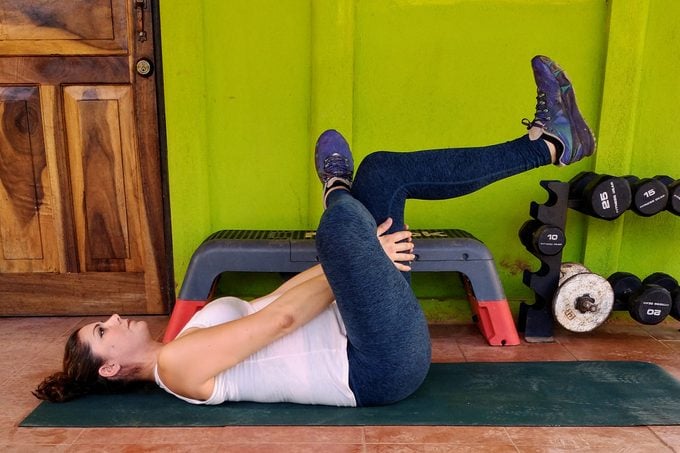
How to do it
Lie on your back on a mat with your knees bent and feet planted on the floor.
Lift your right foot from the floor and cross it over your left thigh. The outside of your right calf should rest on your left thigh.
Open your right knee outward as far as you comfortably can, creating a 4 shape with your legs.
If your glutes are particularly tight, you might already feel a stretch in your butt and hip region. You can stop the stretch and hold it here if you feel a good stretch.
To push the stretch further, lift your left foot from the ground and position your left knee and hip at 90-degree angles.
Grasp the back of your left thigh with both hands and gently pull your left thigh closer to your torso, deepening the stretch to the outside of your right glute and hip.
Stop when you reach a comfortable stretch. Hold the position for 30 seconds before releasing your left foot to the floor.
Repeat on the opposite side. Complete a total of two to three sets per leg.
90/90 Stretch
The 90/90 stretch is another great way to stretch the glutes, particularly the gluteus medius and minimus. It also targets the piriformis and TFL.
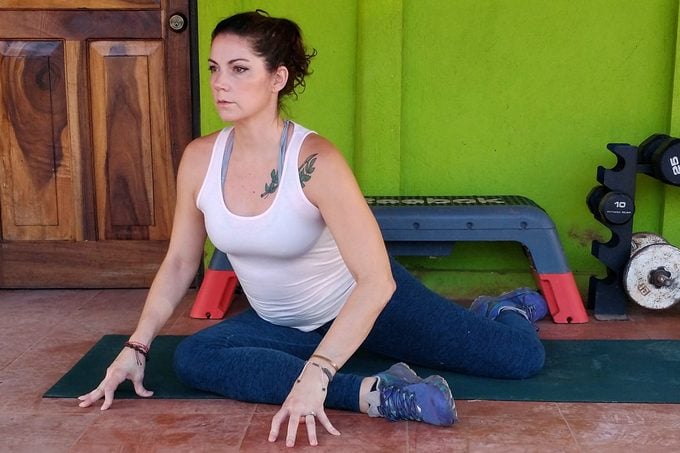
How to do it
Sit on a mat with your knees bent, feet flat on the floor. Allow your right knee to open outward, so the outside of your right leg is touching the mat.
Next, move your left leg behind you, rotating your hip inward as you sweep your leg backward so the inside of your left leg is touching the ground.
Keeping your torso upright and tall, check the position of both legs and use your hands (if necessary) to make small adjustments—you want both knees to be bent 90 degrees.
Twist your torso slightly so it’s squared with your right leg. Your hips should be level and aligned.
You may already feel a stretch to the outside of your right glute and hip, and you might also feel one on the inside of your left thigh.
If this position feels like a good stretch, hold it here.
If you can go further, take a breath in, check your posture, and engage your core. As you exhale, walk your hands forward in front of your right shin, tipping forward from your hips to lean over your leg. This will deepen the stretch on the outside of your right glute.
When you reach the end of your stretch, hold the position for 30 seconds.
Release, then repeat two more times before switching sides.
(Try these leg exercises for a more well-rounded workout.)
Half Lotus Stretch
The half lotus stretch requires some decent flexibility through your hips and glutes, as it strongly targets your hip rotators (your glutes, TFL, and piriformis) as well as your ankles.
That said, if you don’t think you can enter the stretch while sitting flat on a mat, try an easier version: sit on a raised surface, like a cushion or a yoga block.
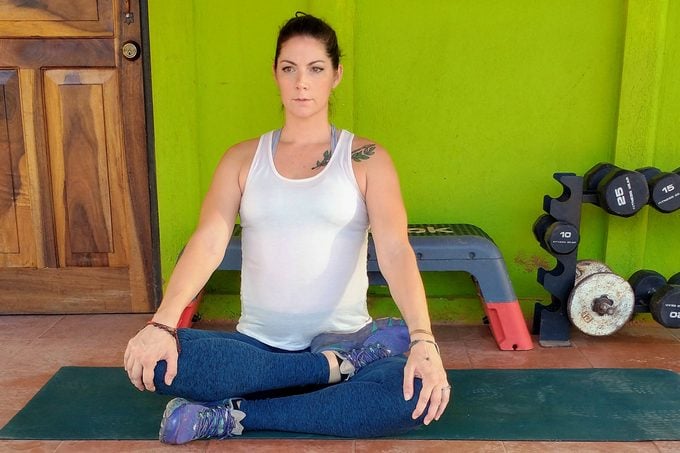
How to do it
Sit on a mat (or your cushion or yoga block) with your legs crossed, your ankles under the opposite thigh.
Check your posture by taking a breath in, rolling your shoulders back, engaging your core, and stacking your ears over your shoulders and hips.
It’s important to maintain good posture while performing the half lotus. Using your hands to assist you, lift your right ankle from the ground and place it on top of the inside of your left thigh.
In the correct position, your left foot and ankle will remain under your right thigh, while your right foot and ankle rest on top of your left thigh. You’ll still be in a cross-legged position.
Regardless of where you place your right foot, you may already feel a good stretch through the outside of your right hip and glute. If so, maintain the position here.
If you can go further, use your hands to bring your right heel closer to your torso. Stop when you feel a stretch.
If you can go even further, place your hands on the floor in front of your shins. Take a breath in, and as you exhale, tip forward from the hips to deepen the stretch to the outside of your right glute and hip.
When you reach the endpoint of your stretch, hold the position for 30 seconds. Release the stretch and repeat it on the opposite side.
Complete a total of two to three stretches per side.
(Don’t overlook stretching your hip flexors.)
World’s Greatest Stretch
The “world’s greatest stretch” gets its name from the fact that it targets almost every major muscle group in the body, including the glutes, hamstrings, chest, spine, and calves.
It’s a great stretch to use as part of a dynamic warm-up before a workout, or you can hold the position in a static stretch for an after-workout cooldown.
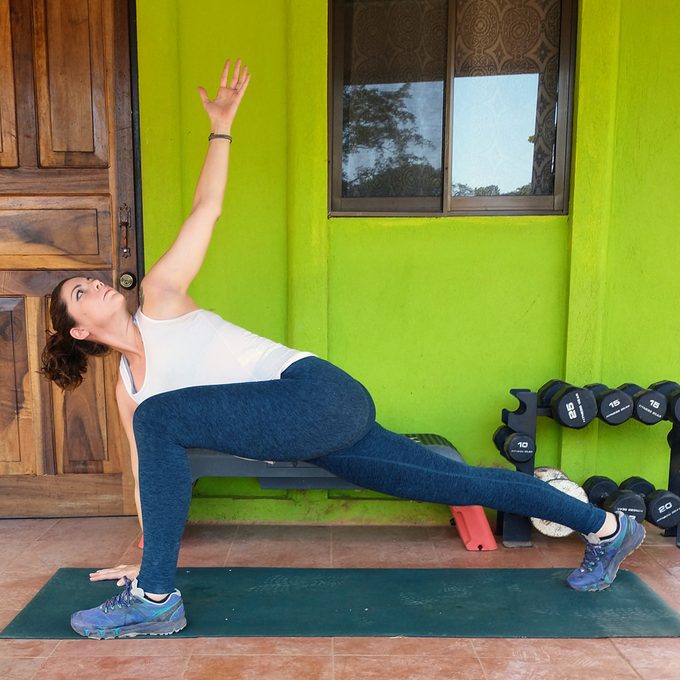
How to do it
Start in a high plank, or push-up, position on a mat. Your palms will be planted under your shoulders, and your body will form a straight line from heels to head.
Keeping your core engaged and your body straight, lunge forward with your left foot, planting it to the outside of your left hand. You’ll feel a nice stretch through your hips in this position.
From here, lift your left hand from the ground and sweep it toward the ceiling until your fingers are pointing straight up. As you raise your arm, rotate your torso to the left, opening your chest wide to feel a stretch through your chest and shoulders.
You may already feel a good stretch through your hips, calf, chest, and back in this position. If so, maintain the stretch here.
But if you want to deepen the stretch to the outside of your left glute and hip, allow your left knee to open outward. The outside of your left foot will rest on the ground.
If you’re performing this stretch as part of an active warm-up:
Hold the position for a breath before reversing the movements and returning to the plank position.
Repeat on the opposite side and continue alternating sides until you’ve performed 10 stretches per side.
If you’re performing this stretch as part of a flexibility routine or cool down:
Hold the stretch for 20 to 30 seconds before repeating on the opposite side.
Complete a total of two to three sets per side.
Next, here are the dynamic stretches you should do before your workout.

